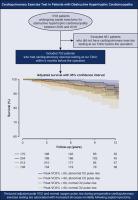The Journal of Thoracic and Cardiovascular Surgery ( IF 4.9 ) Pub Date : 2022-05-28 , DOI: 10.1016/j.jtcvs.2022.05.025 Hao Cui 1 , Hartzell V Schaff 1 , Thomas P Olson 2 , Jeffrey B Geske 2 , Joseph A Dearani 1 , Rick A Nishimura 2 , Daokun Sun 1 , Steve R Ommen 2

|
Objective
The study objective was to analyze performance on cardiopulmonary exercise testing and its prognostic value in patients with obstructive hypertrophic cardiomyopathy undergoing septal myectomy.
Methods
We reviewed patients with obstructive hypertrophic cardiomyopathy who had cardiopulmonary exercise testing before septal myectomy from 2005 to 2016. Causes of functional impairment and their impact on survival were analyzed.
Results
A total of 752 patients had cardiopulmonary exercise testing at a median of 16 days (interquartile range, 2-56) before myectomy. The median exercise time was 6.6 (5.3-8.0) minutes. Functional aerobic capacity was 64% (53%-75%) of predicted, and metabolic equivalent of task was 5.2 (4.1-6.4). The peak oxygen consumption was 18.0 (14.2-21.9) mL/kg/min, which was 60% (49%-72%) of the predicted value. The primary causes for low peak oxygen consumption were impaired cardiac output (73.7%), limited heart rate reserve (52.0%), and obesity (48.2%). Resting outflow tract gradient correlated poorly to peak oxygen consumption, but the use of beta-blockers was associated with reduced peak oxygen consumption. During a median (interquartile range) of 9.0 (6.8-11.7) years of follow-up, the estimated 5- and 10-year survivals were 97% and 91%, respectively. Greater adjusted peak oxygen consumption (hazard ratio, 0.98; P = .011) and abnormal pulse oxygen increase (hazard ratio, 0.44; P = .003) were independently associated with better long-term survival after myectomy.
Conclusions
Among patients with hypertrophic cardiomyopathy undergoing septal myectomy, functional capacity is severely impaired despite receiving optimal medical treatment. We identified risk factors of reduced long-term survival from preoperative cardiopulmonary exercise testing that may aid risk stratification in patients undergoing septal myectomy.
中文翻译:

梗阻性肥厚型心肌病患者的心肺运动试验
客观的
研究目的是分析接受室间隔肌切除术的梗阻性肥厚型心肌病患者的心肺运动试验表现及其预后价值。
方法
我们回顾了 2005 年至 2016 年在室间隔肌切除术前进行心肺运动测试的梗阻性肥厚型心肌病患者。分析了功能障碍的原因及其对生存的影响。
结果
共有 752 名患者在肌切除术前平均 16 天(四分位距,2-56)进行了心肺运动测试。中位运动时间为 6.6 (5.3-8.0) 分钟。功能性有氧能力为预测值的 64% (53%-75%),任务代谢当量为 5.2 (4.1-6.4)。峰值耗氧量为18.0(14.2-21.9)mL/kg/min,为预测值的60%(49%-72%)。低峰值耗氧量的主要原因是心输出量受损(73.7%)、心率储备有限(52.0%)和肥胖(48.2%)。静息流出道梯度与峰值耗氧量相关性较差,但β受体阻滞剂的使用与峰值耗氧量降低相关。在中位(四分位距)9.0(6.8-11.7)年的随访期间,估计的 5 年和 10 年生存率分别为 97% 和 91%。更大的调整峰值耗氧量(风险比,0.98; P = .011)和异常脉搏氧增加(风险比,0.44; P = .003)与子宫切除术后更好的长期生存独立相关。
结论
在接受间隔肌切除术的肥厚型心肌病患者中,尽管接受了最佳的医疗治疗,但功能能力仍严重受损。我们通过术前心肺运动测试确定了长期生存率降低的风险因素,这可能有助于对接受间隔肌切除术的患者进行风险分层。











































 京公网安备 11010802027423号
京公网安备 11010802027423号